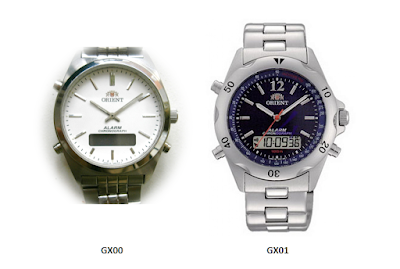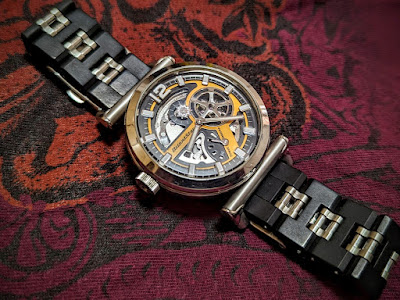A
few months ago I posted an article here
about Orient's digital watches. However, throughout most of its history, Orient
stayed true to analog watch designs, even during the 1980s when much of the
production went quartz.
Could
the two worlds, the digital and the analog, converge? They sure could. A
possible driver that accelerated this trend was the introduction of the
Breitling B1 in 1998. An heir to the 1985 Aerospace, the B1 added a couple of
chronograph-style buttons for a sportier look. Orient, as we know, was never
late to pay homage
to a successful design.
Orient
adopted the Miyota T241 Analog-Digital quartz movement to form the basis for
the new watch. The model was identified as a family of references starting with
VZ00 (all T241-based models were identified by the VZ movement code).
The
T241-based models featured all the goodies one could expect from a digital
watch, including perpetual date correction, millisecond stopwatch and
count-down, chime, and more.
The
design proved a success – while immediately recognizable, it was different
enough from the Breitling and its soon-to-arrive cheap copies, and definitely
much better built than most lookalikes. And it was smaller than the B1, at 42mm
vs 43mm, and lighter.
In
a move also quite typical of Orient, it then took the design and evolved it to
be less derivative and more unique, giving birth to four more variations,
VZ01-VZ04, each of which can be found in a few colorways.
One
thing that the T241 lacked was a backlight for its LCD display. Orient could (and
did) add lume to the analog hands, but the digital display was thus rendered
mostly useless in the dark. This might have been the main reason that Orient
introduced a second line of Ana-Digi models, with the GX movement code.
The
GX movement was probably also cheaper, having just one digital display instead
of the VZ dual display, allowing a lower cost of these new models. It was also
generally simpler, for instance only offering a "complete calendar"
instead of perpetual – namely, the February month-end date had to be adjusted for
leap years. But it did include backlight.
The
GX lineage was much shorter than the VZ; admittedly, it was not as attractive.
Orient also tried some other designs, but none was as popular as the VZ00, and
the further the brand tried to distance its styling from the VZ00's, the less
successful it was. In fact, while most of Orient's ana-digi watches remain
fairly obscure, the long-discontinued VZ00 remains highly sought after to this
day.
Orient's
Japan-made lineup does not feature any new analog-digital watches. Yet, some
consolation can be found in the production of sibling Orient Brazil.
Pictured
above are two of the Brazilian branch Solartech models, featuring a single
digital display. This watchmaker also produces Anadigi models under its Neo
Sports line, with two LCD displays. As you can expect, these are beefy 45mm
watches, not at all bad looking, and fairly hard – though not impossible – to
obtain outside Brazil.
Pictures
that appear in this post were taken from old Orient catalogs, user manuals, Orient Brazil website, and sale ads.


















